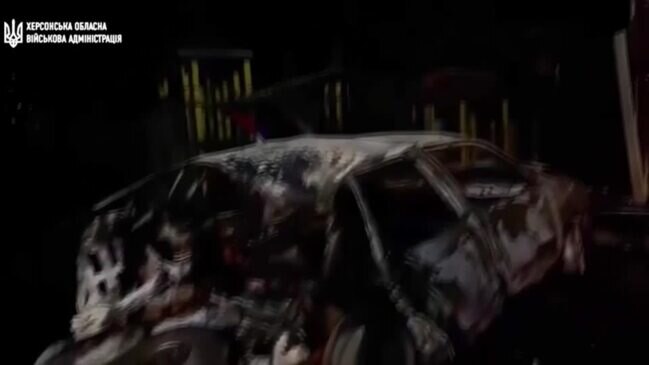Cultural gems looted by Russia
Days before their withdrawal, Moscow’s troops fleeced supermarkets, but the southern Ukrainian city suffered another violation – the theft of its historic artefacts.

It was not the drunken, opportunistic looting seen in other places in Ukraine; when the Russians arrived at the Kherson regional museum they knew exactly what they wanted.
They ignored displays of local flora and fauna, the dusty cases of stuffed hedgehogs and birds. There were soldiers among them as well as civilians, including cultural officials from Russian-occupied Crimea. They marched straight to the masterpieces at the heart of the museum’s collection.
Over the course of several days at the end of last month, they loaded the treasures on to trucks and drove away.
“They had expert people with them,” Elena Yeremenko, the museum’s secretary, said. “There were about 70 labourers who loaded it all up.
“They took swords, guns, our collection of weapons. They took coins, icons, gold necklaces, 18th and 19th-century furniture. This was not just looting – this was theft by the Russian state.”

Since being liberated by the Ukrainian armed forces two and a half weeks ago, the sufferings inflicted on Kherson in southern Ukraine have become painfully clear. There are the crimes of violence in occupied cities across the country – arbitrary arrest and detention, torture and rape.
In the days before their withdrawal, Russian soldiers plundered supermarkets of alcohol and food. They even stole a raccoon from a zoo. But Kherson suffered another violation on a scale not documented elsewhere: the wholesale theft of its cultural heritage.
Across the road from the history museum, the Kherson Regional Art Museum lost 10,000 paintings – removed less than two weeks before the withdrawal, without any attempt at concealment. The manner of the official looting reveals much about Russian attitudes towards Ukraine, as well as the sympathy for the occupiers among parts of the Kherson population.
“Everyone asks what is the motivation for doing this?” Ms Yeremenko said. “I think it’s an attempt to steal Ukrainian history, to monopolise history.”
The stripping of both museums came from a struggle between pro and anti-Russian members of staff that began before the invasion and centred on two powerful women.
Tetiana Bratchenko, 73, the director of the history museum, left Kherson for Crimea in October. Ms Yeremenko said she was an able manager who studied history at St Petersburg University. But she was an admirer of Russia who co-operated with the occupiers when they seized Kherson in March.
Staff with pro-Ukrainian sympathies left or were sacked, including Ms Yeremenko, who was in charge of administrative functions. “The director knew my attitude to Putin,” she said. “I told her, ‘The Russians will fail: Russians always fail’. I worked here for 20 years and I was fired. She accused me of being a traitor.”
Across the road, the art museum is run by Alina Dotsenko, also 73, a fierce Ukrainian nationalist.
By chance the museum was being refurbished and all its paintings were in storage. With three trusted employees, Ms Dotsenko copied the digital catalogue on to a memory card.
A Russian official asked her to hold a victory exhibition. “I swore at him,” Ms Dotsenko said. “I come from a noble family and it’s the first time I’ve sworn in my life.” The next day she left for Kyiv, with the memory card hidden.

She was replaced by a former cabaret singer. A woman she had sacked for pro-Russian sympathies returned with her own copy of the catalogue. She showed the Russians where the paintings were hidden. Three days after the history museum had been stripped, the lorries pulled up outside.
“I wanted to cry,” Anya Skrypka, an archivist at the museum, said. “This collection belonged to the whole city. We wanted to give it to our children.”
The Russians took about 10,000 of 14,000 pieces in the collection, leaving behind only those that were too big. The lost art includes work by Sir Peter Lely, the 17th-century English artist, August von Bayer, the 19th-century German, Ivan Aivazovsky, the Crimean Romantic, and many Ukrainian artists. The history museum lost several rooms of treasures, including gold necklaces from the Scythian period and an exquisite Damascus steel sabre with a silver scabbard owned by the Emir of Bukhara. The occupiers even took a copy of the 19th-century Kherson newspaper, South, from the library.
The museums refuse to help the looters by putting a value on the missing items but they are irreplaceable.
A war crimes unit of the Ukrainian Territorial Defence Forces is investigating the looting of the artefacts, seen being unloaded at the Central Museum of Tavrida in Simferopol, Crimea. Andrei Malgin, the museum’s director, told The Moscow Times, the items were in “temporary storage … until they are returned to their rightful owner”.
Witnesses have told Captain Vitaliy Tytych, who is investigating the theft, the most precious items, including the sabre, have not been sent to Crimea.
“It was organised at a high level,” Mr Tytych said. “Russia tries to justify it in terms of protecting cultural property. But they are stealing our history. Russia has been trying to steal our history for centuries. They’re trying to join something that cannot be joined.”
– The Times



To join the conversation, please log in. Don't have an account? Register
Join the conversation, you are commenting as Logout